|
Join Alaska's top scenic Road & Alaska Railroad journey from Anchorage. Visit some of Alaska's best destinations during the 10-day rail & driving vacation: experience soft-adventure activities on the Kenai Peninsula with world-class Kenai River salmon fishing and rafting trips. Travel through Prince William Sound with over 10,000 square miles of protected waterways, islands, fjords, as well as 10,000 glaciers besides Columbia Glacier. Prince Willian Sound provides natural habitat for whales, porpoise, sea otters, sea lions and seals. Drive from Valdez to the pictureque ghost town of Kennicott in the heart of the Wrangell-St. Elias National Park, visit Fairbanks where you can enjoy excellent aurora sightings beginning in mid-August and take a scenic rail tour to see the "Great One" Mt. Denali, in the heart of Denali National Park. |
RRSD#03 Spectacular by Nature: Alaska Self Drive and Rail Tour
Tour Itinerary
Dates | Rates
Options | Extensions
Accommodation
Rental Car
Railroad FAQ
|
Day
01 |
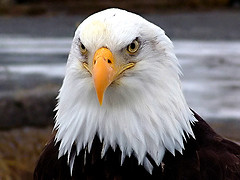 |
Anchorage Upon arrival in Anchorage transfer to your hotel. Pick up your rental car and get ready for an Alaska vacation of a lifetime. Anchorage features dozens of parks and 122 miles of paved bike paths. Warmed by a maritime climate, you can spend the day salmon fishing at Ship Creek, hiking the nearby mountains, photographing glaciers and dining at a four-star restaurant. Within a 15-minute drive from downtown on the hillside is the tree-lined trailhead of Anchorage’s most popular hike, Flattop Mountain. A short floatplane ride opens up the possibility of almost any type of adventure. That’s one reason why Lake Hood is the world’s busiest floatplane base. Try some fresh Alaska seafood (Salmon, Halibut and Dungeness Crab) for dinner in one of the many excellent restaurants around the hotel. Afterwards enjoy a stroll along the coastal trail with sweeping views of Mt. Denali and Mt. Susitna aka: the "Sleeping Lady". |
|
Day
02 |
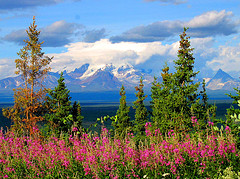 |
Anchorage - Seward | Kenai Fjords National Park The drive along the scenic Seward Highway offers incomparable vistas of fjords, glaciers and mountains as you follow the Cook Inlet and Turnagain Arm. Like many communities in Southcentral Alaska, Seward began a new era of history in 1964 after the Good Friday Earthquake caused fires and tidal waves that destroyed 90 percent of the town. One of the only reminders of the natural disaster can be seen in the public library where the slide show covering the earthquake, “Waves Over Seward,” is shown. This afternoon you have time to visit the Exit Glacier just north of town. This road-accessible glacier offers an impressive up-close view of the glacier along with information and hiking trails. The more adventurous may take a guided kayak trip and spend the afternoon paddling among sea otters. Check out the Alaska SeaLife Center - Alaska’s premier public aquarium and marine mammal rehabilitation facility. Enjoy a delicious seafood dinner at the boat harbor. Distance: 130 Miles |
|
Day
03 |
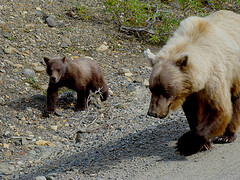 |
Seward - Cooper Landing | Kenai River This morning board the catamaran and enjoy a spectacular glacier and wildlife cruise. Our 110-mile long cruise - hosted by a National Park Ranger who provides narration - takes you deep into Kenai Fjords National Park. You'll visit the Holgate or Aialik Glacier - the largest tidewater glaciers within the park which are active "calving" glaciers and often massive chunks of ancient ice will plummet into the sea below. Your cruise experience continues with a visit of the Chiswell Islands National Wildlife Refuge - an important marine bird sanctuary were millions of seabirds are nestling on nearly vertical islands. Last but not least, you see a small rookery of the endangered Steller Sea Lions and have a good chance to spot Orca and Beluga whales within the Gulf of Alaska (Cruise: 8 AM - 2PM). Short drive to Cooper Landing. The Russian and Kenai Rivers are providing some of the best and most productive salmon fishing in Alaska. Four species of salmon - by the hundreds of thousands - find their way into the rivers and lakes to return to where their lives began. |
|
Day
04 |
 |
Cooper Landing - Whittier - Prince William Sound | Ferry Trip - Valdez Leave the Kenai River area and take the scenic Seward Highway for a drive across the Chugach Mountains and along Turnagain Arm to the glacier studded Portage Valley. To access the remote community of Whittier - your departure terminal for the ferry trip to Valdez - you travel through the Anderson Memorial Tunnel - North America's longest shared rail and vehicle tunnel. The Prince William Sound is one of the few places left in the world where a concentration of glaciers can be found in such abundance. During the comfortable ferry trip you cruise past Esther Passage, view majestic alpine and tidewater glaciers covered with ancient ice (Columbia Glacier) from the distance and may observe a large variety of marine wildlife. A US Forest Service ranger will point out interesting sites along the way. Watch for playful sea otters, harbor seals, kittiwakes, bears, whales or mountain goats. Distance: 65 Miles + Ferry Trip |
|
Day
05 |
 |
Valdez - Fairbanks Leave Valdez and drive through Keystone Canyon towards the Worthington Glacier area. Stopover for a glacier hike before continuing your journey along the Wrangell-St. Elias Mountains - renowned as an avid outdoor paradise for world-class salmon fishing on the Copper River and exciting hiking or rafting trips. Drive through Paxson with it's many sled dog kennels and further on to Delta Junction - a telegraph station established in 1904. The intersection, marked by an oversized white milepost for Mile 1422 of the Alaska - and Richardson Highway, is known as the Triangle. Delta Junction is also home to the 90,000-acre Delta Bison Sanctuary, which was created to contain a free-roaming herd of more than 500 animals. The area features spectacular views of the Alaska Range and the Delta River. On clear days the panoramas of Mount Hayes 13.832 ft, Mount Moffit 13.020 ft and other peaks are stunning. Distance: 365 Miles |
|
Day
06 |
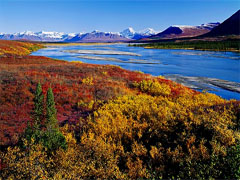 |
Fairbanks In 1902, Felix Pedro found gold in the region and thousands of prospectors swarmed to the area in search of the “Mother lode.” Nearly a century later, Fairbanks (population 32 000) is the trade and transportation center for Interior and Far North Alaska. From mid-May through July, visitors can enjoy more than 20 hours of sunlight a day. Today you have the unique chance to join an arctic flight to Alaska's vast, roadless interior. Enjoy the scenic flight above the arctic circle and experience how the Gwich'in Athabascan Natives live in "Bush" Alaska. Put your hand in the Yukon River, travel through the wetlands and crest the rounded peaks of the Northern Edge of the Alaska Range looking out for moose and dall sheep. Another option is to drive along Chena Hot Springs road (watch out for moose!), go on a hiking trip and visit Chena. Relax in the large heated indoor or natural outdoor rock lake. Step into the Aurora Ice Museum and grant yourself to a "Appletini" beverage served in an ice glass. |
|
Day
07 |
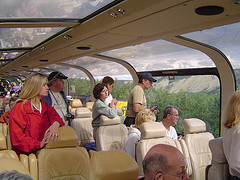 |
Fairbanks - Denali National Park | Rail Tour This morning board the Alaska Railroad in Fairbanks. Choose between standard and glass-domed train compartments with large panorama windows and unobstructed views of snowcapped mountains, pristine scenery and wildlife. Enjoy the scenic rail tour south via Nenana - known for its Alaska Ice Classics - and further on to Denali. You will be picked up at the Denali Park Rail Station and transferred to your hotel. Free afternoon for activities. Option: Take the opportunity and join us for a flightseeing trip around Mt Denali's 20.320 ft summit and get a picture perfect view of the Kahiltna and Ruth Glacier with its Great Gorge - over 9.000 ft deep - as well as onto magnificent ice-falls. See the Sheldon Amphitheatre and add on a glacier landing at the base of Mt. Denali. Experience the excitement of standing among the great peaks - the immense scale will astound you. |
|
Day
08 |
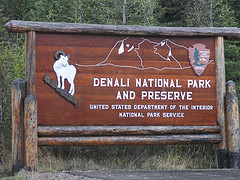 |
Denali National Park Early (pre-reserved time) shuttle bus departure - the park road is closed for private vehicles - for a full day wildlife observation and sightseeing tour to the Eielson Visitor Center in the shadows of Mt. Denali - with 20.320 ft. the highest mountain peak in North America. Option: exchange the shuttle bus tour to the Tundra Wilderness or Kantishna Roadhouse Tours. Please inquire. The “Great One”, crowns the 600-mile long Alaska Range. The views from here are just spectacular. Watch for grizzly bears, moose, caribou, wolf and lynx roaming throughout the park and 150 different bird species inherit the Denali Park area. The park was created 1980 from the former Mt McKinley National Park. At over 6 million acres, the park is larger than the US State of Massachusetts. It exemplifies interior Alaska’s character as one of the world’s last great frontiers for wilderness adventure and it remains largely wild and unspoiled. |
|
Day
09 |
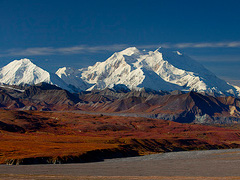 |
Denali National Park - Anchorage | Rail Tour Board the Alaska Railroad and relax in your comfortable reclining seats, enjoy a delicious lunch in the onboard restaurant or listen to the local tour guide giving commentaries. Have your camera ready as the train crosses Hurricane Gulch Bridge, 300 feet above the creek. Your rail tour continuous via Wasilla - home of the Alaska Iditarod Sled Dog Race - to Anchorage. Transfer from the rail station to your Anchorage hotel. Try some fresh Alaska seafood for your dinner and enjoy a evening stroll along the Tony Knowles Coastal Trail with sweeping views over the inlet. |
|
Day
10 |
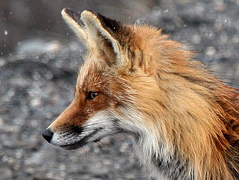 |
Anchorage Time for some last minute shopping activities or to visit the Alaska Heritage Center - devoted to the lifestyles of Alaska’s native peoples, this center's building is a relatively compact facility in which brief exhibits and regular performances depict the Athabascan, Yupik, Inupiaq and coastal nations that have lived here for millennia. The centerpiece of the facility is a lovely path around a small pond, through birch and cottonwood forest, that leads to a half-dozen authentic dwellings - most of them heavily earth-insulated against the harsh climate. Free shuttles take visitors from downtown to the center during the summer. End of your Self Drive and Rail Tour. Optional program extensions are available. Please contact us. |
| Rates in US $ / per Person | Single | Double | Triple | Quad | Child | |
| May 10 - May 31 | $5087.00 | $2926.00 | $2274.00 | $1948.00 | $419.00 | |
|
|
||||||
| June 1 - August 31 | $5355.00 | $3049.00 | $2343.00 | $1990.00 | $425.00 | |
|
|
||||||
| September 1 - September 20 | $5087.00 | $2926.00 | $2274.00 | $1948.00 | $419.00 | |
| Rates in US $ / per Person | Single | Double | Triple | Quad | Child | |
| May 10 - May 31 | $6075.00 | $3572.00 | $2793.00 | $2403.00 | $619.00 | |
|
|
||||||
| June 1 - August 31 | $6826.00 | $3948.00 | $3037.00 | $2582.00 | $624.00 | |
|
|
||||||
| September 1 - September 20 | $5985.00 | $3519.00 | $2751.00 | $2366.00 | $619.00 | |
| Daily Departures from May 10 - September 20 |
|
| Rates in US $ | per Person | Adult |
| Cooper Landing: Half Day / Full Day Kenai River Salmon Fishing Trip | |
| Cooper Landing: Six Mile Creek Whitewater Rafting Trip | |
| Fairbanks: 5 hr Arctic Circle Flightseeing Tour to Fort Yukon & the Yukon River | |
| Fairbanks: 3 hr Riverboat Discovery Sternwheeler Cruise | |
| Exchange Shuttle Bus to Escorted 8-Hour Tundra Wilderness Tour including Boxed Lunch | |
| Exchange Shuttle Bus to Escorted 13-Hour Kantishna Wilderness / Backcountry Lodge Tour with Lunch, Interpretive Program, Gold Panning, En-route Refreshments Departure: 6:00 am / Return 7:00 pm |
|
|
Superior Hotel Category (*** Hotels, Motels & Lodges) Superior Hotels offer a good amount of essential guest services and are located in downtown locations and/or in/near national park areas. All superior class hotel rooms are equipped with a private bathroom. Example larger hotel chains for superior class hotels are: Holiday Inn, Howard Johnson, Guesthouse Inn, Ramada Inn, High Country Inn, Aspen Hotel Group, Comfort Inn. As you might be aware, that these hotel chains are not available throughout Alaska. In such cases or/and when we feel that Alaskan owned hotels & lodges offer a better experience, we go with that choice. Cabins and Cottages also considered in this category to make your experience even more ‘Alaskan’. We ensure that all the Cabins & Cottages have a private bath to make your stay comfortable. 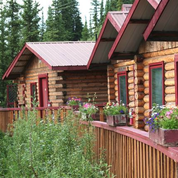 First Class Hotel Category (**** Hotels & Lodges) First Class hotels usually offer an additional amenities such as a restaurant, lounge, bar, fireplace seating, fitness room, swimming pool/hot tub, etc. All rooms in First Class hotels belong to a higher category and are always equipped with a private bathroom. Most hotels in this category are usually located in prime locations in prime downtown locations or in national parks. These include larger hotel chains such as: Marriott Hotels, Sheraton, Westmark Hotels, Princess Hotels and Lodges, Clarion Suites, Comfort Inn & Suite. The larger hotel chains are only available in Anchorage and Fairbanks. If a major hotel chain is not available, we prefer to book local premium hotels/deluxe cabins or cottages for our clients. Please note that premium accommodations may not be available in small towns; in such cases we will book the best available accommodation. 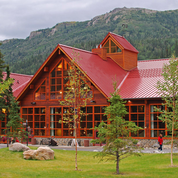 |
Rental CarWe’ve put together a selection of rental car categories designed specifically with Alaska travel in mind. Whether you’re planning a short getaway or a longer adventure, traveling solo or with a group, or working within a specific budget, you’ll find options that balance comfort, space, and practicality for the unique conditions of Alaska’s roads. From midsize cars for easy city driving to spacious SUVs and vans ideal for longer scenic routes or family trips, there’s a category for every type of journey. Not sure which vehicle is right for your plans? Simply reach out to us—we’ll be happy to recommend the rental car category that best matches your itinerary, group size, and travel style. Here are the car rental categories we offer: Mid Size Car (included - part of the package / additional day $150) Generally, midsize cars measure between 180 to 195 inches in length but can vary depending on specific models. Mid-size cars, also commonly known as intermediate or standard cars, are four-door sedans that are more spacious than compact cars while still being fuel-efficient. They can fit 3 or sometimes 4 bags depending on the model. They feature more interior space compared to compact cars and offer comfortable seating for four to five passengers.  Full Size Car (upgrade $12 per day / additional day $160) Full Size cars are what many people would describe as large cars. A full-size car typically refers to a vehicle that offers more extensive interior space, comfort, and power compared to smaller vehicles such as compact or midsize cars. These cars usually have larger dimensions, including length, width, and height. They commonly feature roomy interiors with ample seating for five or more passengers along with expanded trunk capacity for luggage or cargo. Historically, full-size cars were synonymous with large sedans boasting V8 engines and body-on-frame construction. While this has changed over time due to evolving industry trends and technological advancements, what remains consistent is the emphasis on spaciousness, comfort, and performance these vehicles provide.  Standard Size SUV (upgrade $88 per day / additional day $240) SUVs (short for sport or suburban utility vehicles) are good-sized vehicles with a rugged look, set higher off the road than normal cars. In an SUV, the description of “standard” generally refers to the size of the SUV. The standard SUV is larger than the intermediate or compact versions. These full-size models are more powerful, like a truck, and they are usually more equipped to handle a wider variety of terrains and road conditions as well. In addition to being powerful, their size also means that they typically have more seating capacity than the smaller SUVs. They can seat more passengers and have more cargo space for transporting luggage and equipment.  Standard Elite SUV (upgrade $105 per day / additional day $255) Perfect for families, groups, and adventurous travelers, the Standard Elite SUV delivers a spacious and comfortable ride with room for up to 7 passengers. These versatile SUVs combine strong performance with practical features, including automatic transmission and air conditioning, making them ideal for both city streets and Alaska’s rugged landscapes. Models in this category offer generous cargo space for luggage, gear, or supplies, ensuring every trip is smooth and stress-free. With their reliable handling, powerful engines, and family-friendly interiors, Standard Elite SUVs are built for travelers who want comfort, convenience, and confidence on the road. Book from this vehicle group to enjoy a safe, capable, and spacious SUV designed to make every journey a memorable adventure. 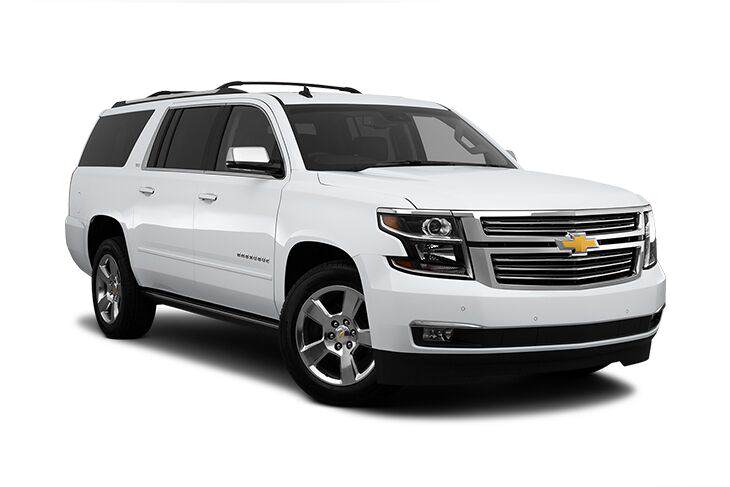 Mini Van (upgrade $125 per day / additional day $275) This roomy mini van is your ticket to family adventures and travel memories on your next rental. More spacious than a full-size car, and with better gas mileage than an SUV, a minivan is a 7-passenger van that provides unbeatable comfort and convenience. By providing leg and luggage room, configurable seating and storage layouts, easy in-and-out, competitive fuel efficiency, and high-performance drive—all without sacrificing style—minivans accommodate every kind of group outing, from lengthy family vacations to quick business trips. Did somebody say “road trip”?  11 Passenger Van (upgrade $250 per day / additional day $400) Choose a 11-person passenger van so that no one gets left behind on your road trip or vacation. Instead of trying to coordinate a car pool; save time, resources, and gas money by putting everyone together in one clean and comfortable van. You'll find each passenger has much more leg room. Sample Models: Chevrolet Express, Ford Transit or similar Sample Features: 3 Doors –10 to 11 Passengers- 6 Large Suitcases - Air-conditioning - Automatic Transmission 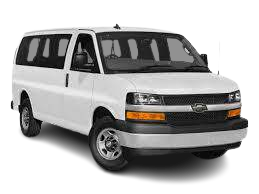 |
 |
| Alaska Rail Tour Services Regular Seating and Private Dome Car Choices Our Alaska Rail Tours are available with the following classes of service: Denali Star, Adventure Class Service | Many people prefer the standard class for its single level stability, generous seating and the ability to easily walk between different cars on the train. Gold Star Dome Cars Are the newest first-class rail cars in Alaska with large picture windows and fine dining options. Upper level dome car 360-degree viewing seating, priority check in, outdoor viewing deck. The lower level provides a restaurant, bar and gift shop. Midnight Sun Express Dome Cars | These 2-story dome cars with large multiple outside viewing platforms are operated by a private company. Enjoy the full-time 360-degree view dome seating with plenty of leg – and storage room. Additional features are: GPS assisted monitors, restaurant, bar and gift shop. The 1950’s Vintage Cars | The 1950's-era vintage railcars built by the well known Budd Company were some of the last reminders of the Golden Age of rail. A private company began acquiring Budd dome cars for passenger service on the McKinley Explorer train in Alaska. The seven cars the: Matanuska 508, Chena 509, Chulitna 510, Tanana 512, Talkeetna 513, Kashwitna 553 and Eklutna 554 were purchased and completely refurbished. These railcars were to become the most historic and elegant way to travel through America's Last Frontier. Mc.Kinley Explorer Dome Cars | Are the largest domed cars ever build with plenty of legroom, wide isles and additional luggage storage space. The seats are on the upper level – with restaurant, gift shop and bar downstairs - providing a 360-degree view through the glass windows around and the glass dome above you. All seats are wired so you may listen to music and recorded narration. GPS assisted monitors in each car are tracking the exact location. The covered outside viewing platform is a great feature for a breath of fresh air. All Alaska Rail Tours are including a pre-confirmed and assigned seat as well as on-board narration services. |
| Children Rate We provide a reduced tour rate for children up to 11 years. Please refer to each individual tour for more information. Children will be accommodated in parents room. |
| Dining The Midnight Sun Express, the McKinley Explorer and the Alaska Railroad Gold Star Dome Cars are offering full service breakfast, lunch and dinner options (all custom made to order) at the on-board restaurants. You will have the opportunity to visit the dining room and order freshly prepared food from the menu. Since all of our dishes are prepared to order we will do our best to accommodate all dietary concerns. Please notify us of any special dietary requirements at the time of reservation. Alcoholic beverages are also available. |
| Gratuities Recommended gratuities to the on-board train staff and host guides are $3.00 to $5.00 per person and day. Gratuities for meal and bar service are entirely discretionary, but 15% is customary in most Alaskan restaurants. All tipping is a matter of your individual preference and is of course - always voluntary. |
| Hotel Accommodation For additional information and addresses on hotels, lodges and resorts included in your railroad tour package, please check our „Info Center“ area. |
| Luggage Transfer & Access Passengers are limited to two pieces of checked baggage, not to exceed 50 pounds, that must be checked with the Alaska Railroad without charge. Each passenger may also take one carry on, not to exceed 2 ” by 14” by 17 ”, which will stored under your seat on the viewing level. Please pack any medications, cameras, binoculars or valuables in your carry-on. |
| Pets Are not allowed onboard (except assistance dogs) |
| Smoking Is not permitted on-board the trains. Smoking is allowed outside on the platforms. Ashtrays are available on the outside viewing platform. |
| Sightseeing Tours Most of our tours are including scheduled sightseeing trips. For more information please refer to each individual tour package. In addition to these scheduled tours we also provide a variety of exciting optional sightseeing trips with a great value. Please Note: Optional sightseeing tours are only available in connection with a confirmed rail tour package reservation. |
| Tickets & Travel Documents You’ll receive your boarding passes, travel documents and additional tour information on the departure day at the rail station. Ticketless travel options are available upon request. |
| Transfers Most scheduled transfers indicated within the itinerary are included in our rail tour packages. Optional pre/post hotel tour accommodation are including transfers from/to the airport. Private limousine and/or group coach transfers are available for an additional charge. |
| Wheelchair Access Each train has at least one rail car that this fully accessible to wheelchairs. A specially designed lift makes getting on and off the train easy and safe. There are also accessible restrooms on each of the accessible rail cars. |
| Alaska Rail Tour Travel Destinations Anchorage to Talkeetna | Anchorage is headquarters to the Alaska Railroad and the journey to Fairbanks begins here. Several miles into the trip, the heavy birch forests of Eagle River and Chugiak lead to the Knik and Matanuska Rivers.The expansive watershed harbors wildlife like moose, bear, the occasional wolf and abundant waterfowl. About 40 miles from Anchorage comes the Matanuska Valley, Alaska's agricultural center and home to the towns of Palmer and Wasilla. Just south of Talkeetna, 70 miles further, the first view emerges of Mt. Denali, North America's highest peak. The train takes its first stop in Talkeetna, a small town with a mining history and now, a popular takeoff point for climbers to Mt. Denali. Talkeetna to Denali | From Talkeetna, the track follows the serpentine banks of the Susitna River. On clear days, more views of Mt. Denali emerge across the river presenting many chances for photos. Black and brown bear frequent the sandbars and scuttle into the brush as the train approaches. Next, the Indian River Canyon is home to many beavers and beaver lodges can be seen in the ponds along the way. The track climbs toward tree line, first crossing Hurricane Gulch, the longest bridge on the railroad just over 914 feet and 296 feet above Hurricane Creek. The train moves into Broad Pass, at 2,363 feet it's the highest point on the railroad, and where caribou migrate through during the fall. Thousands of travelers visit Denali National Park and Preserve to see wildlife like wolves, caribou, Dall sheep, moose and bear, and, of course, Mt. Denali. Denali to Fairbanks | The coal-mining town of Healy follows after a 10-mile jaunt through Healy canyon, where the surging waters of the Nenana River cuts through the steep-sided cliffs. As the track levels out, Nenana comes into view. It is home to one of the remaining original Alaska Railroad Depots, now a museum and gift shop. The track cuts through the northern boreal forests of interior Alaska. Birch, aspen and willow fill this landscape where gold miners first came to seek their fortunes. Fifty-eight miles from Nenana, Fairbanks, the "Golden Heart City" signals the end of the line - but just the beginning for more adventure, culture and history in the Last Frontier. Seward to Anchorage | Your journey starts in Seward, the southern terminus of the railroad. It quickly begins its climb through primeval forests of Sitka spruce. After crossing Snowy River, Kenai Lake comes into view, set off with its stunning aqua color and surrounded by soaring mountains. Moose Pass - Thirty miles into the trip, the track winds through Moose Pass, a former railroad construction camp on the shores of Trail Lake. As the rail ascends into the Kenai Mountains, it leaves behind the forests and reveals mountain meadows and streams of gin-clear glacial waters. Trail Glacier appears on the right and soon after, the summit of Grandview at 1,063 feet and the historic Loop District - named for a complex series of trestles built to handle the steep grade in the age of steam engines. In the same stretch, Bartlett Glacier crowds the track just 800 feet away. Placer River Valley - After passing through a series of short tunnels, the track descends to the Placer River Valley near Spencer Glacier. Moose, bear and wolves populate the valley among the willow and alder trees. Trumpeter swans migrate through in spring and fall and arctic terns hover above the ponds and river looking for small fish and insects. Twelve miles later Turnagain Arm appears, where 40-foot tides rush into the narrow confines of the Chugach Mountains. Beluga whales pursue salmon and other schooling fish. Next comes Girdwood, home to Alaska's premier ski resort, a 40-mile commute from Anchorage. Chugach National Forest - The Chugach National Forest borders Turnagain Arm, some six million acres, the second largest in the U.S. Bald eagles cruise the thermals above and Dall Sheep come to feed on the low plants growing on the cliffs bordering the track. Next comes Potter Marsh in the Anchorage Coastal Wildlife Refuge. Anchorage is the final stop, 114 miles out of Seward. |
